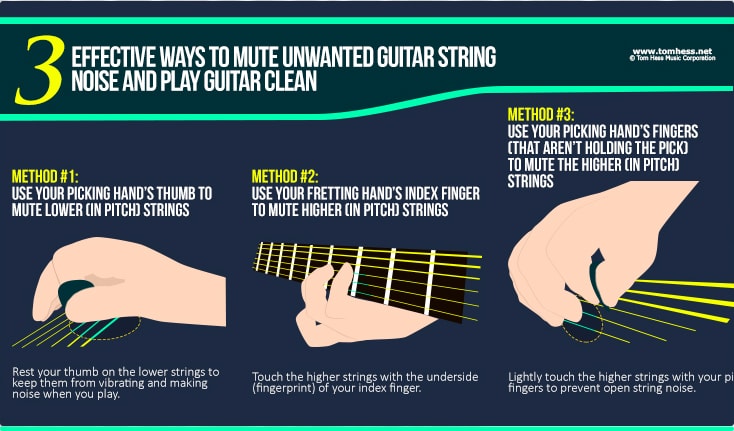Guitar Vibrato Lesson – Avoid These Common Guitar Vibrato Mistakes
by Tom Hess
Emotion To Any Guitar Lick

EMAIL TO GET ACCESS
By submitting your info, you agree to send it to Tom Hess Music Corporation who will process and use it according to their privacy policy.
Here is a failsafe way to become a better lead guitar player:
Master your lead guitar vibrato.
The better your vibrato - the better you sound when you play all your lead guitar licks and guitar solos.
It doesn't matter if you play fast guitar licks or slow lead guitar licks…
… great guitar vibrato makes every note you play drip with emotion.
Emotion To Any Guitar Lick

EMAIL TO GET ACCESS
By submitting your info, you agree to send it to Tom Hess Music Corporation who will process and use it according to their privacy policy.
Problem is:
Most lead guitar players don’t know how to do guitar vibrato well.
Why?
2 reasons:
Some take guitar vibrato for granted and don’t practice it. (They assume or hope that their vibrato will develop on its own.)
Others make common lead guitar vibrato mistakes that make their vibrato sound less expressive than it could and should be.
Watch this video to discover the most common lead guitar vibrato mistakes and how to fix them to make all your lead guitar licks and guitar solos sound better:
Now that you know the most important mistakes to avoid in your vibrato… want to know even more guitar vibrato tips that will quickly make you a much better lead guitar player?
No problem. Check these out:
Lead Guitar Vibrato Tip #1. Avoid Too Much Similarity In Your Guitar Vibrato
I once had a lead guitar student show me a guitar solo he wrote. And I must say: everything about that lead guitar solo (the guitar licks, the phrasing, the technique) was pretty much spot-on.
But one thing was “off”.
His vibrato had a lot of similarity from one guitar lick to another.
Meaning:
Whenever he applied guitar vibrato to a note, he always went to the vibrato directly. Same way an opera singer adds instant vibrato to every note.
And he articulated the notes with vibrato in a similar way as well.
So, to help my lead guitar student, I decide to not touch any of the cool lead guitar licks and guitar solo ideas he had in his solo…
… and we focused only on refining his guitar vibrato.
Here is what I taught him:
There are 2 main variables to control when playing guitar vibrato in a lead guitar solo:
1. ‘How’ your vibrato sounds (a combination of how wide it is and how fast its pulses occur)
2. ‘When’ the vibrato occurs on a note after the note is played.
Problem is:
Most guitarists use vibrato in the exact same way in their guitar solos (either always narrow or always wide), and always apply guitar vibrato in the exact same way every time they use it.
They usually play a note and immediately add vibrato on top of it without letting the note breathe.
When you do this without being aware of it, your guitar licks will quickly lose their novelty and your guitar solo will sound repetitive and predictable.
After teaching my student this, I had him spice up the vibrato in his guitar licks by ‘delaying’ it for a few moments after he played a note in his guitar solo. This not only made his lead guitar phrasing sound different, but it added extra musical tension to his guitar vibrato and added fire to the guitar licks in his guitar solo.
Here is an excerpt of the lead guitar lesson I gave to my student. Use it to improve your guitar vibrato (and other areas of lead guitar playing):
Want to hear the difference between instant vibrato and delayed vibrato?
Check out these examples:
Example 1 - Instant Guitar Vibrato: Hear It
Example 2 - Delayed Guitar Vibrato: Hear It
To add even more variety to your soloing, delay the guitar vibrato and strike the string again to re-articulate/add extra power to the note. Here is an example of how this sounds:
Example 3 - Delayed Guitar Vibrato With Re-Articulation: Hear It
The lesson for you is: go through your guitar licks and guitar solos that you already think you know well.
Your goal is to vary how you do vibrato in those guitar licks.
For example: Use more delayed vibrato. Use vibrato less often (on fewer notes) or more often (on more notes).
Vary the speed of your guitar vibrato.
Do a double stop guitar vibrato (vibrato on 2 notes at a time). Etc.
Any of these variations will make your “old” guitar licks sound new… all because of how you are doing guitar vibrato.
Lead Guitar Vibrato Tip #2. Treat Guitar Vibrato As Rhythmic String Bends.
I often see guitar players do guitar vibrato by shaking (rocking) the string from side to side. And there are a few problems with this:
1. This vibrato is not appropriate for rock lead guitar. Classical guitar players do this vibrato on a nylon string guitar. But (good) rock lead guitar players don’t do this kind of guitar vibrato in their guitar licks and guitar solos.
2. The “rocking the hand back and forth” guitar vibrato makes your entire guitar solo sound nervous. That’s because this kind of guitar vibrato is both narrow and fast.
Anytime you use narrow and fast vibrato in the guitar licks of your guitar solos – there is only one result: your playing sounds out-of-control and nervous. This is the opposite of what good rock and metal lead guitar vibrato should feel like.
The solution?
If you want to do guitar vibrato fast (in your guitar licks and guitar solos) it must be wide - not narrow.
But if your guitar vibrato is slow – make it narrow. (Guitar vibrato that’s slow and wide sounds like string bends, instead of awesome guitar vibrato).
The best way to practice control over your guitar vibrato is to play it with a metronome. Yes, practice guitar vibrato with a metronome, same way you would practice your guitar technique to a metronome.
This does a few things to improve your lead guitar playing:
It forces you to sync your guitar vibrato in time with the click. (Which then helps you apply your guitar vibrato when you use it in guitar licks and guitar solos over songs.)
This also gets you to practice transitions from slow and narrow vibrato to fast and wide guitar vibrato.
Watch this guitar vibrato video to see what I mean:
Question: Tom Hess, what finger(s) should I use when doing lead guitar vibrato?
Answer: Short answer is: All of them.
The long answer is this:
It’s best to use more than one finger to do guitar vibrato.
Meaning: as the middle finger does guitar vibrato, use the index finger to help out. (Squeeze it into the fret right next to the middle finger.)
When you do guitar vibrato with the ring finger, the middle and index fingers can both help you out.
And yes, you can do vibrato with the pinkie finger as well.
Ironically, the index finger is the weakest finger to do vibrato with.
Why?
Because it can’t get any help from the other fingers.
(But you can definitely do guitar vibrato with only the index finger as well.)
 Improve Guitar Technique Fast
Improve Guitar Technique FastLearn how to quickly improve
your accuracy on lead guitar.
 Transform Your Guitar Playing
Transform Your Guitar PlayingInstantly improve your guitar
playing with these free tips.
 Become A Faster Guitar Player
Become A Faster Guitar PlayerLearn how to reach maximum
speed in your guitar playing.
Start with making a list of lead guitar players you think play with great guitar vibrato.
Andy Larocque, Paul Gilbert, Yngwie Malmsteen, Zakk Wylde are examples of guitar players who play guitar licks and guitar solos with incredible guitar vibrato.
Start by studying them if you don’t have a list of your own yet.
Transcribe their (slow) lead guitar licks from their guitar solos. Focus on matching the sound of their vibrato specifically.
Simply *trying* to do it will quickly make your guitar vibrato sound better too. (Even if you struggle with through the process initially.)
Tip: Do your best to describe exactly the difference between your guitar vibrato and the guitar vibrato of lead guitar players you are analyzing.
Is it too fast? Too slow? Too wide? Too narrow? Not in tune? Is there string noise?
What precisely as missing? The more specific you can be when describing your problem, the easier it is to come up with a solution.
That said, even though there are many lead guitar players who can play guitar licks and guitar solos with incredible vibrato…
I modeled *my* guitar vibrato after singers – not lead guitar players. And I recommend you do it too. (Or at least: use great singers to influence your guitar vibrato.)
Here is why:
Great singers have exceptionally good vibrato (and all aspects of their phrasing). Why? Because, unlike lead guitar players, singers can’t “play” a lot of “lead guitar” notes.
So, they have to make every note they sing sound amazing.
That’s why everything about their musical phrasing is often close to perfect.
And here is your lead guitar assignment that will help tremendously with your guitar vibrato:
1. Make a list of your top 5 favorite singers.
2. Make a list of 2-3 of your favorite songs of theirs. (That feature their best singing.)
3. Transcribe their vocal parts on your guitar. But focus specifically on matching the vibrato nuances with your guitar licks.
It helps if the singers whose vibrato you are going to don’t all do vibrato the same way.

Lead Guitar Vibrato Tip #4: Practice Getting Your Vibrato In Tune.
One of the most common guitar vibrato mistakes is not keeping your vibrato in tune when you play guitar licks.
It happens like this:
You bend the guitar string to start your vibrato, but then you either:
- Don’t bend the string up to the correct pitch.
- Don’t release the string all the way back down (which makes the note you are applying vibrato to sound out of tune).
- Bend the string a different amount for each pulse of your guitar vibrato…
… or do some combination of the above 3 points.
Here are several ways to solve this:
1. Record your lead guitar playing (and your guitar vibrato practice). But not in the way you probably think.
After you record yourself practicing guitar vibrato, listen back at half speed (using headphones).
This will help your ears to easily tell if your vibrato is in tune or not (even if your musical ear isn’t very advanced yet).
2. Practice your guitar vibrato using a drone. A drone is a static pitch that’s sustained for a long time. You can find drone tones for free online. (Just do a Google search.)
When you do vibrato to a drone, it becomes extremely obvious when your guitar vibrato is or isn’t in tune.
You can then make the necessary adjustments in your guitar licks to make your guitar vibrato in tune.
Lead Guitar Vibrato Tip #5. Mute Sloppy Excess String Noise When You Do Guitar Vibrato
You know anybody who loves the sound of sloppy lead guitar playing?
No? Me neither.
If your lead guitar playing fills with noise every time you do guitar vibrato, one thing is for sure…
…You will sound bad!
How do you prevent and control string noise during guitar vibrato?
3 basic ways:

The most important of these is thumb muting.
This means: rest your picking hand’s thumb on the lower (in pitch) strings to keep them quiet when you play lead guitar.
For example: say you are playing a guitar lick with vibrato on the 3rd string. Your thumb should cover strings 4 5 and 6 while you bend the 3rd guitar string.
As you change strings, your thumb should glide along and always cover the strings below the one you are playing. (This is true no matter which guitar string you are adding guitar vibrato to.)
Watch this video to see thumb muting in action and use it to clean up your vibrato:
Another important lead guitar technique for muting excess string noise is…
The underside of your fretting hand finger.
Just like it sounds: you simply rest the underside of your index finger on the higher (in pitch) strings - muting them.
You can also rest the ring finger of your picking hand on the higher strings to mute them when guitar vibrato happens.
Question: "Tom Hess, what if my finger bumps into the lower (in pitch) string when I do guitar vibrato? What should I do?"
Answer: You have 2 options:
1. Use an adjacent finger to rest on the lower string muting it. For example: when doing vibrato on the 3rd string with the middle finger, mute the 4th string with the index finger.
Muting = lightly touch the string.
2. Use your guitar pick to pull the lower strings out of the way to create more room for the string you do vibrato on.
You can do one or the other (or both).
Now that you know how quickly improve your guitar vibrato, what’s next?
The next step is to take ALL of your other musical skills to an advanced level and turn your guitar playing into something you can feel immensely proud of.
I can help you with this in my personalized Breakthrough Guitar Lessons. Unlike some other guitar lessons, you don’t get generic, cookie-cutter lessons from me.
You get guitar lessons personalized to your specific guitar playing challenges, musical skill level, musical interests, and of course: your unique musical goals. Hundreds of my guitar students are experiencing nearly lifechanging breakthroughs in their playing as we speak.
To become one of them, click the green “Start Now” button on the banner below to learn more.
 About Tom Hess: Tom Hess is a guitar teacher, music career mentor and guitar teacher trainer. He teaches rock guitar lessons online to students from all over the world and conducts instructional live guitar training events attended by musicians from over 50 countries.
About Tom Hess: Tom Hess is a guitar teacher, music career mentor and guitar teacher trainer. He teaches rock guitar lessons online to students from all over the world and conducts instructional live guitar training events attended by musicians from over 50 countries.
 | Forward this article to your friends |

